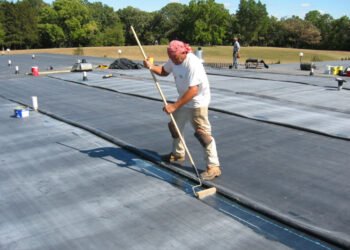Your roof is an essential component of your home, providing a critical barrier between you and the external environment. Not only does it keep out harmful weather elements such as rain, snow, ice, and hail, but it can also help maintain a comfortable temperature indoors and insulate against noise pollution. However, over time your roof may experience various issues due to regular wear-and-tear which can compromise its performance. For this reason, it is important to be aware of the signs that indicate your roof needs repair or replacement so you can take appropriate action to avoid more significant damages down the line
Signs that show you need to fix your roof.
1.Age of the roof
Age plays a big role as one of the signs that show you need to fix your roof. The age of a roof is an important factor when it comes to timely maintenance and repairs. The average lifespan for most roofs generally ranges from 20-25 years, but this will vary depending on the type of materials used in the construction. If your roof is nearing or has exceeded this timeframe, it’s imperative to have it inspected by a professional for any potential problems that may not be visible. As roofs age, they become more vulnerable to leaks, deterioration of shingles, and other damages that can compromise its integrity over time if left unchecked. Regularly inspecting your roof is essential in order to identify any potential issues early and prevent costly repairs down the line. By understanding the age of your roof and scheduling regular inspections, you can ensure optimal performance and prolong its lifespan significantly.
2.Leaks and water stains
Leaks and water stains are common problems that can occur in roofs, especially those that have been aging or improperly installed, making emergency roof repair essential in such situations. Stains on the walls or ceilings can indicate the presence of a leaky roof, with discoloration often appearing in brown or yellow hues. If this is observed, it is essential to immediately investigate the source of the leak since leaving it unchecked can result in further damage such as mold growth, weakened structural elements, and more costly repairs. Possible causes of leaks include damaged shingles, deteriorated flashing, improperly sealed joints, clogged gutters, or even faulty installation. With timely detection and repair, homeowners can avoid more serious and expensive issues stemming from roof leaks.
3.Damaged or missing shingles
Damaged or missing shingles can significantly impact the longevity of your roof. Shingles serve as a protective layer, protecting your roof from harsh weather conditions and high winds. They will curl, crack, or come loose over time due to exposure to UV rays, storms, and other elements. If these problems go unaddressed, they can lead to water penetration and further damage such as rot, mold growth, and structural issues. To ensure that your roof remains in good condition, it is essential to regularly inspect it for any signs of damage or missing shingles. You can do this yourself from the ground or hire a professional inspector to take a closer look. Promptly replacing these damaged elements when they are discovered is a key part of preventive maintenance and will help extend the life of your roof by ensuring that it remains adequately protected against the elements.
4.Granule loss
Granule loss is a common issue that can occur in asphalt shingle roofs. Asphalt shingles are coated with granules which provide them with UV protection and enhance their durability. However, over time, these granules can start to shed off due to weathering or aging. This process can be accelerated in areas with heavy sun exposure and high temperatures, making granule loss a common problem in warmer climates. Symptoms of granule loss include a buildup of these tiny particles in gutters and bald spots on the shingle surface. If left unaddressed, this can lead to roof deterioration and make the structure more vulnerable to leaks and other damages. To determine the extent of the issue, it is best to consult a certified roofing professional who can help assess whether repairs or a full replacement are necessary. Taking proactive measures to address granule loss as soon as possible is key for protecting the longevity and integrity of your roof.
5.Sagging roof deck
A sagging roof deck is a serious structural issue that requires prompt attention. It usually occurs when moisture accumulates over time and affects the integrity of roof supports or rafters, causing them to rot or weaken. A sagging roof deck can be identified by a visible dip or sag in your roofline; it is imperative to contact a professional roofing contractor as soon as you notice this problem. Ignoring this issue can lead to catastrophic consequences such as a roof collapse, which can endanger the lives of anyone in the vicinity and incur significant material losses. Therefore, it is essential to take immediate action if you suspect that your roof deck may be sagging, and avoid putting off repair works until it’s too late. Doing so will ensure the safety of your home and its occupants while preventing costly damage in the future.












